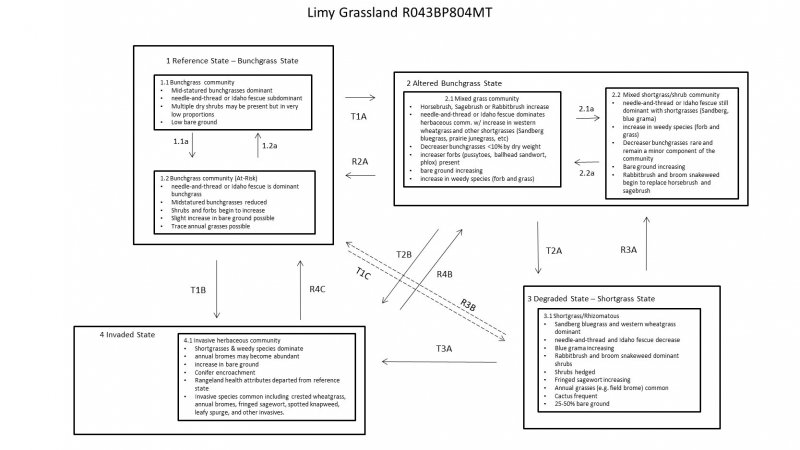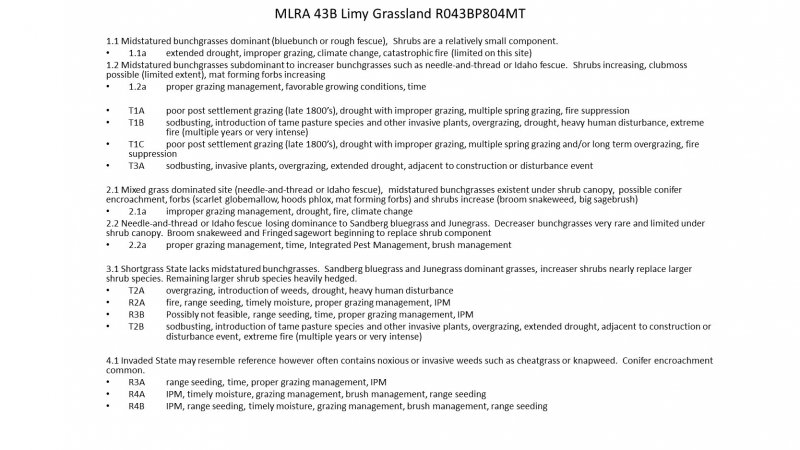
Natural Resources
Conservation Service
Ecological site R043BP804MT
Limy Grassland Group
Last updated: 3/01/2024
Accessed: 12/21/2025
General information
Provisional. A provisional ecological site description has undergone quality control and quality assurance review. It contains a working state and transition model and enough information to identify the ecological site.
MLRA notes
Major Land Resource Area (MLRA): 043B–Central Rocky Mountains
The Central Rocky Mountains (MLRA 43B) of Montana occupy some 28,850 square miles and exist primarily in Central and SW portions of the state. The climate is extremely variable with precipitation lows of 9 to 100 inches per year and frost free days of less than 30 to over 110 days. The geology of the region is also highly variable. The combination of variable climate and geology create a complex relationship of plant communities. MLRA 43B elevations typically exist between 6000 and 12,799ft at Granite Peak (the highest point in Montana).
The Continental Divide runs through this MLRA effectively splitting its watershed to contribute to either the Missouri River to the East and the Columbia River to the West.
Ecological site concept
• Site does not receive any additional water
• Soils are
o Generally not saline or saline-sodic (limited extent)
o Moderately deep, deep, or very deep
o Typically less than 5% stone and boulder cover (<15% max)
o Strongly or violently effervescent within surface mineral 4”; calcium carbonates increase with depth
• Soil surface texture ranges from sandy loam to clay loam in surface mineral 4”
• Area of rugged mountain, hills, plateaus, and valleys of the Central Rocky Mountains in Southwest Montana
• Site Landform: fan remnants and hillslopes
• Moisture Regime: arid ustic to typic ustic
• Temperature Regime: cryic to frigid
• Dominant Cover: rangeland (grass dominated)
• Elevation Range: 3800-6700ft
• Slope range: 2-45% (typically less than 15%)
Site Development and Testing Plan
This Provisional Ecological Site Description was developed to meet the criteria as defined in Soil Survey National Instruction part 306 (430-306-NI, April 2015) as interpreted by Regional Ecological Site Specialist. Information in this description are first approximations based on broad groupings of soil properties and vegetation characteristics associated with those groupings. Although this description has been through the quality control and quality assurance review process it has not been certified for use in conservation planning.
Associated sites
| R043BP810MT |
Shallow Grassland Group Shallow Grassland is often located higher on the landscape; positioned on the shoulders of nearby hills. The Shallow Grassland has root restrictive layers (such as lithic and paralithic contact) at less than 20 inches below the soil surface. |
|---|---|
| R043BP811MT |
Shallow Sagebrush Shrubland Group Shallow Sagebrush Shrubland is often located higher on the landscape; positioned on the shoulders of nearby hills. The Shallow Sagebrush Shrubland has root restrictive layers (such as lithic and paralithic contact) at less than 20 inches below the soil surface. |
| R043BP805MT |
Limy Sagebrush Shrubland Group Limy Sagebrush Shrubland is often immediately adjacent to and intermixed with the Limy Grassland site as a complex. These sites share landscape position, hydrological processes, and often have the same soil components. |
Similar sites
| R043BP805MT |
Limy Sagebrush Shrubland Group Limy Sagebrush Shrubland is often intermixed with the Limy Grassland site on a landscape level. These two sites share similar plant community species and have similar State and Transition Models. The Limy Sagebrush Shrubland will typically express a slightly lower overall production value |
|---|---|
| R043BP810MT |
Shallow Grassland Group Shallow Grassland has a root restrictive layer less than 20 inches below soil surface. It shares similar plant community species and has similar State and Transition Models with the Limy Grassland. The Shallow Grassland will typically express lower overall production values. |
| R043BP811MT |
Shallow Sagebrush Shrubland Group Shallow Sagebrush Shrubland has a root restrictive layer less than 20 inches below soil surface. It shares similar plant community species and has similar State and Transition Models with the Limy Grassland. The Shallow Sagebrush Shrubland will typically express lower overall production values. |
Table 1. Dominant plant species
| Tree |
Not specified |
|---|---|
| Shrub |
(1) Artemisia tridentata |
| Herbaceous |
(1) Pseudoroegneria spicata |
Click on box and path labels to scroll to the respective text.

